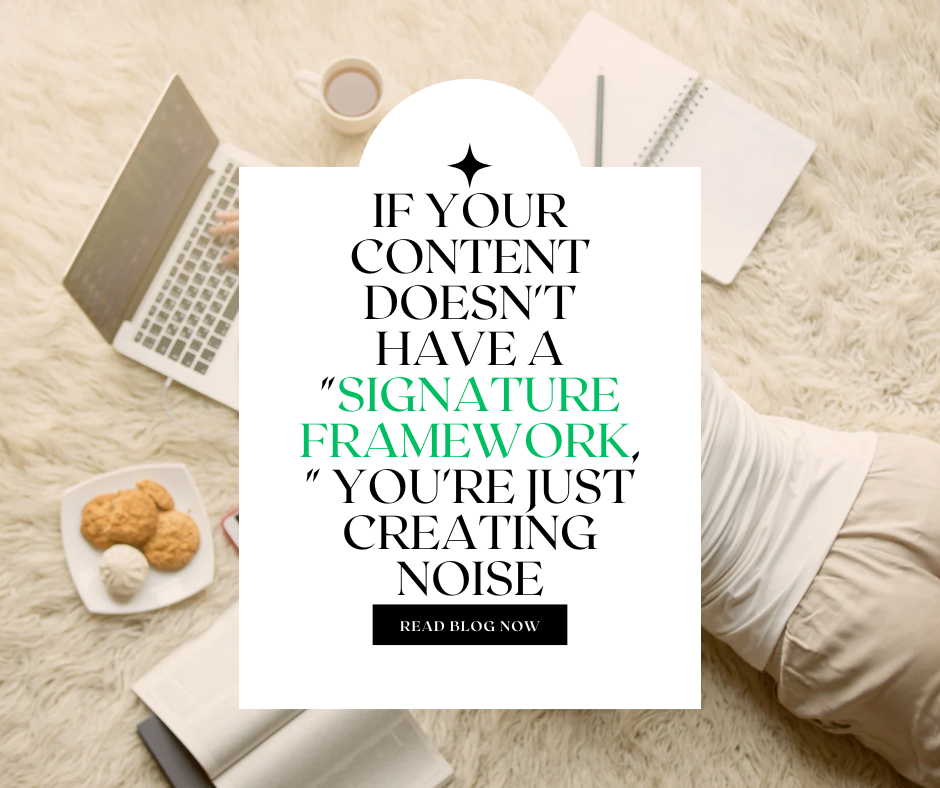The Strategic Importance of Developing a Signature Framework for Content Differentiation

Introduction
In today’s saturated digital landscape, content creators face an unprecedented challenge: how to distinguish their expertise from the countless voices sharing similar insights. While producing high-quality, helpful content remains essential, it is no longer sufficient for establishing thought leadership or building a memorable personal brand. The solution lies in developing what industry experts call a “signature framework” – a proprietary methodology that transforms generic advice into distinctive intellectual property.
This article explores the strategic importance of signature frameworks, their impact on content effectiveness, and provides a systematic approach for developing your own branded methodology.
The Challenge of Content Commoditization
Contemporary content creators encounter several critical challenges that limit their impact and growth:
Information Overload and Audience Fatigue The average professional consumes vast amounts of content daily, making it increasingly difficult for individual pieces to achieve lasting impact. Generic advice, regardless of its quality, often fails to create memorable impressions in oversaturated information environments.
Lack of Intellectual Property Rights When content creators share common knowledge or best practices, they essentially become interchangeable sources of information. This commoditization undermines their ability to establish unique market positioning or command premium pricing for their expertise.
Difficulty Establishing Expert Authority True expertise is characterized not merely by knowledge possession, but by the development of unique methodologies and approaches. Without proprietary systems, even highly knowledgeable professionals may struggle to be perceived as definitive authorities in their fields.
Defining the Signature Framework
A signature framework represents a structured, proprietary system for addressing specific challenges or achieving particular outcomes. It consists of several key components:
- Clear Problem Definition: The framework addresses a specific, well-defined challenge
- Systematic Approach: It provides a logical sequence of steps, phases, or principles
- Unique Methodology: The approach reflects the creator’s distinctive perspective and experience
- Memorable Branding: It features a distinctive name that facilitates recall and discussion
- Practical Application: The framework delivers measurable results when properly implemented
Strategic Benefits of Signature Frameworks
Enhanced Market Differentiation
Signature frameworks create immediate distinction in crowded markets. Rather than competing on generic capabilities, creators establish unique intellectual territories that competitors cannot easily replicate.
Improved Content Memorability
Branded methodologies leverage cognitive psychology principles that enhance recall. Named systems create mental anchors that help audiences retain and apply information more effectively than isolated tips or advice.
Elevated Expert Positioning
Proprietary frameworks signal innovation and thought leadership. They demonstrate that the creator has not merely accumulated knowledge, but has synthesized experience into original methodologies.
Scalable Content Strategy
Frameworks provide sustainable content generation strategies. Each component can be explored in depth, creating natural content series and educational programs without risk of topic exhaustion.
Premium Value Proposition
Intellectual property inherently commands higher value than generic consulting or advice. Frameworks enable creators to position their offerings as unique solutions rather than commoditized services.
Framework Development Methodology
Phase 1: Core Competency Analysis
Begin by conducting a thorough assessment of your unique value proposition:
- Problem Identification: Analyze the specific challenges you consistently address for clients or audiences
- Approach Documentation: Record your typical problem-solving methodology, including unconscious steps you may take intuitively
- Unique Angle Assessment: Identify what distinguishes your approach from standard industry practices
Phase 2: Process Systematization
Transform your intuitive approach into a replicable system:
- Step Sequencing: Organize your methodology into logical, sequential phases
- Outcome Definition: Clearly articulate what each phase achieves and how it contributes to the overall result
- Resource Requirements: Identify tools, information, or conditions necessary for successful implementation
Phase 3: Brand Development
Create memorable nomenclature that enhances framework adoption:
- Descriptive Accuracy: Ensure the name clearly communicates the framework’s purpose
- Memorability Features: Incorporate alliteration, metaphors, or rhythmic elements that aid recall
- Market Differentiation: Verify that your chosen name distinguishes your framework from existing methodologies
- Professional Appropriateness: Balance creativity with professional credibility requirements
Phase 4: Visual Communication Design
Develop clear visual representations that facilitate understanding:
- Structural Diagrams: Create simple graphics that illustrate the framework’s logical flow
- Phase Distinction: Use visual elements to differentiate between framework components
- Audience Accessibility: Ensure visual designs are appropriate for your target demographic
Phase 5: Validation and Refinement
Test your framework through practical application:
- Peer Review: Gather feedback from trusted colleagues or mentors
- Real-World Application: Implement the framework with actual clients or projects
- Iterative Improvement: Refine based on practical results and user feedback
Implementation Strategy
Content Integration
Once developed, your signature framework should become the central organizing principle for your content strategy:
- Educational Content: Create in-depth explorations of each framework component
- Case Studies: Document real-world applications and results
- Thought Leadership: Position your framework within broader industry conversations
Business Model Integration
Incorporate your framework into your professional offerings:
- Service Delivery: Use the framework as the foundation for consulting or coaching services
- Educational Products: Develop courses, workshops, or certification programs based on your methodology
- Speaking Opportunities: Present your framework at industry conferences and professional events
Community Building
Leverage your framework to create engaged professional communities:
- Shared Language: Framework terminology creates common vocabulary among practitioners
- Success Stories: Framework users become natural advocates and case study subjects
- Continuous Development: Community feedback drives framework evolution and improvement
Long-Term Strategic Impact
Signature frameworks generate several long-term benefits that extend beyond immediate content marketing objectives:
Intellectual Property Development: Your framework becomes a valuable business asset that can be licensed, franchised, or sold.
Market Authority: Consistent framework promotion establishes you as the definitive expert in your specific methodology.
Business Scalability: Frameworks enable you to train others to deliver your methodology, expanding your reach without diluting your brand.
Legacy Creation: Well-developed frameworks can outlast their creators, establishing lasting professional legacies.
Conclusion
In an era of information abundance, the creation of signature frameworks represents a strategic imperative for serious content creators and business professionals. These proprietary methodologies transform generic expertise into distinctive intellectual property, enabling creators to establish clear market differentiation and sustainable competitive advantages.
The development process, while requiring thoughtful effort and systematic approach, is accessible to any professional with genuine expertise and commitment to methodical thinking. The investment in framework development yields returns through enhanced authority, improved content effectiveness, and expanded business opportunities.
Rather than continuing to contribute to the growing volume of undifferentiated content, consider this an opportunity to develop your unique contribution to your field. Your signature framework awaits development – and with it, your transformation from content creator to recognized thought leader.
Do you want to read more about the relationship advises vist here.




